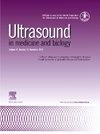利用超声骨骼成熟指数评估儿童是否已达到最终身高。
IF 2.4
3区 医学
Q2 ACOUSTICS
引用次数: 0
摘要
目的:采用超声骨成熟度指标评价儿童是否达到最终身高。方法:于2022年1月至2024年8月进行随访研究。从病历中采集超声骨成熟度指标,包括桡骨、尺骨、股骨的骨化率,以及骨骼成熟度评分(SMS,以上三块骨骨化率之和乘以100),以及儿童的年龄和身高。对儿童进行随访,以确定超声骨龄评估前后2年的身高年增长情况。孩子们根据他们是否达到了最后的高度被分组。确认超声骨成熟度指标对评估儿童是否达到最终身高的诊断效能(曲线下面积,AUC)。结果:共纳入患儿120例,其中男孩60例,平均年龄:男孩15.0±1.7岁,女孩14.1±2.0岁。在达到最终高度时,男孩桡骨、尺骨和股骨骨化率以及SMS的平均值分别为90%、84%、98%和271,女孩为86%、83%、98%和267。超声骨成熟度指标能够评估儿童是否达到最终身高,男孩的最高AUC为0.99 (95% CI: 0.97, 1.01,临界值为256),女孩的最高AUC为0.95 (95% CI: 0.90, 1.00,临界值为260)。结论:儿童骨骼骨化率达到100%前,身高停止增长。超声骨成熟度指标,特别是SMS,在确定儿童是否达到最终身高方面具有很高的诊断价值。本文章由计算机程序翻译,如有差异,请以英文原文为准。
Use of the Ultrasound Bone Maturity Indexes to Assess Whether Children Have Reached Their Final Height
Objective
Ultrasound bone maturity indexes were used to assess whether children had reached their final height.
Methods
The follow-up study was performed between January 2022 and August 2024. Ultrasound bone maturity indexes, including the ossification ratio of the radius, ulna, and femur, and skeletal maturity score (SMS, the sum of the ossification ratio of the above three bones multiplied by 100), were collected from medical records, along with the children's age and height. The children were followed up to ascertain the annual increase in height during the 2 years before and after the ultrasound bone age assessment. Children were grouped according to whether they had reached their final height. The diagnostic performance (area under the curve, AUC) of ultrasound bone maturity indexes in assessing whether the children had reached their final height was confirmed.
Results
A total of 120 children (60 boys) with a mean age of 15.0 ± 1.7 years for boys and 14.1 ± 2.0 years for girls were included. At the attainment of final height, the mean values of radial, ulnar, and femoral ossification ratios, as well as the SMS, were 90%, 84%, 98%, and 271 in boys and 86%, 83%, 98%, and 267 in girls, respectively. Ultrasound bone maturity indexes were able to assess whether children had reached their final height, with the highest AUC for SMS of 0.99 (95% CI: 0.97, 1.01, cutoff value, 256) in boys and 0.95 (95% CI: 0.90, 1.00, cutoff value, 260) in girls.
Conclusion
A child's height stops increasing before the ossification ratios of the bones reach 100%. Ultrasound bone maturity indexes, especially SMS, demonstrate high diagnostic performance in determining whether children have reached their final height.
求助全文
通过发布文献求助,成功后即可免费获取论文全文。
去求助
来源期刊
CiteScore
6.20
自引率
6.90%
发文量
325
审稿时长
70 days
期刊介绍:
Ultrasound in Medicine and Biology is the official journal of the World Federation for Ultrasound in Medicine and Biology. The journal publishes original contributions that demonstrate a novel application of an existing ultrasound technology in clinical diagnostic, interventional and therapeutic applications, new and improved clinical techniques, the physics, engineering and technology of ultrasound in medicine and biology, and the interactions between ultrasound and biological systems, including bioeffects. Papers that simply utilize standard diagnostic ultrasound as a measuring tool will be considered out of scope. Extended critical reviews of subjects of contemporary interest in the field are also published, in addition to occasional editorial articles, clinical and technical notes, book reviews, letters to the editor and a calendar of forthcoming meetings. It is the aim of the journal fully to meet the information and publication requirements of the clinicians, scientists, engineers and other professionals who constitute the biomedical ultrasonic community.

 求助内容:
求助内容: 应助结果提醒方式:
应助结果提醒方式:


